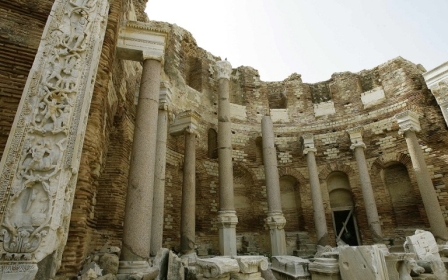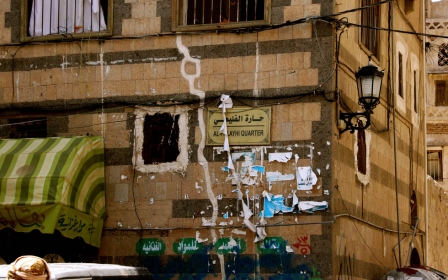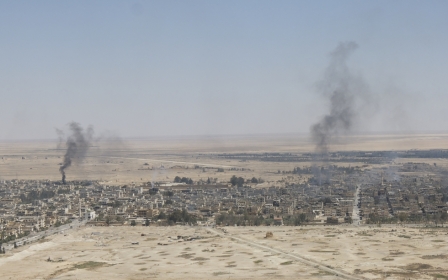Modern-day gladiators battle to save Libya's Roman ruins

Standing guard with an automatic weapon at the gates of Leptis Magna, the Roman city in the Libyan desert that is one of the ancient world’s best preserved sites, Ali Hreibish considers himself a gladiator.
“I’m only a couple of months away from retirement at my job at the power plant,” Hreibish told Middle East Eye, referrring to the electricity facility whose chimney stacks rise on the horizon like distant doric columns.
”But I remember when archaeologists uncovered a gladiator arena next to our farm back in the sixties when I was a child and since then I have come to see myself as one of them.”
Even with Libya wracked by violence and political upheaval, those who have taken on the responsibility of protecting the country’s celebrated ancient heritage have strived to keep the sites safe and open for visitors.
“We’ve learned the lessons from the Iraq war and the Egyptian revolution,” said Hreibish.
“We saw on TV that amid a turbulent security situation, it’s a good time for looters to steal antiquities.”
Security at Libya's classical sites is under scrutiny this week following reports in the Italian media claiming that the mafia was swapping weapons for looted artefacts with Islamic State (IS) group militants.
An undercover reporter for La Stampa newspaper claimed he had been offered the marble head of a Greek statue looted from Libya for 60,000 euros ($66,000) while visiting a salami factory in southern Italy.
Following the 2011 uprising against long-time Libyan ruler Muammar Gaddafi, UNESCO, the United Nations’ cultural agency, urged authorities to protect the country's heritage.
But as that moment of optimism disintegrated into violent unrest, members of local rebel groups and volunteers came together to defend the antiquities themselves.
At Leptis, known as Lebda in modern-day Libya, rebels formed a brigade to guard the ruins, as well as the museums of Bany Walid and the Islamic Museum in Sirte.
“This is even without getting any money for coffee, food or salaries," Hreibish said.
But despite these efforts, UNESCO this year added Libya’s five World Heritage sites to its “danger list” after damage caused by IS to the ancient city of Palmyra in Syria shocked archaeologists and art historians.
IS continues to hold ground around Sirte in the centre of the country, despite recent territorial reverses.
Libya’s other four sites added to the “World Heritage in Danger” list were two more Roman cities, Cyrene and Sabratha; Ghadames, a Berber oasis town in the Sahara; and Tadrart, a site renowned for rock art from 14,000 years ago.
Yet despite concerns, Muhammad Bojelaa, the head of Sabratha’s archaeology office, told MEE that the country had been spared the widespread plunder that followed the US-led invasion of Iraq in 2003 when thousands of items were looted from Baghdad's Iraq Museum within days of Saddam Hussein being toppled from power.
“Muammar Gaddafi always neglected the Department of Antiquities during his rule,” Muhammad Bojelaa, the head of Sabratha’s archaeology office, told MEE.
”But there has been only one incident of antiquity theft here since 2011 when looters stole two Roman busts from the courtyard outside the Sabratha museum.”
Those two pieces were recovered by local armed rebels within weeks according to Bojelaa who is proud of the local respect for antiquities which he believes is inspired by the city’s ancient heritage.
Sabratha’s intact amphitheatre is the only complete Roman structure of its kind remaining from the "three cities" of Tripolis on the Mediterranean coast, about 66km west of Tripoli, Libya’s modern capital.
“However in general, Libya is not stable. The sites need to be fenced and need to be provided with modern alarms to be protected. For now we only rely on local guards and volunteers to protect the site,” said Bojelaa.
Adel Mahmoud, a restoration employee who specialises in mosaics, said the first couple of years after the uprising had been manageable for the antiquities staff.
But the situation had deteriorated since 2014, he said, because of the worsening economic situation and the breakup of Libya into fragments ruled by competing governments, militias and tribal gangs.
That year Islamic militias responded to electoral defeat by seizing Tripoli and setting up a rival assembly to the internationally recognised parliament, known as the House of Representatives. In turn, the House of Representatives moved to the eastern city of Tobruk.
Militias and remnants of the armed forces gravitated toward regional bands called Operation Dawn in the west and Operation Dignity in the east fighting over territory and for control of Africa’s largest oil fields.
Officials at the Antiquities Authority say the unrest forced them to shutter their museums in all cities including Tripoli, and hide the most unique and valuable artifacts in secure locations.
“Citizens offered their homes as hiding places for this valuable heritage because of the fear of looting,” said Mahmoud.
'Citizens offered their homes as hiding places for this valuable heritage because of the fear of looting'
Abed Mahmoud
As the security situation worsened, restoration work came to a halt.
“With the exception of one visit by British experts and the brave teams who came from Italian universities, restoration work has essentially stopped over the last three years,” said Mahmoud.
He said that certain mosaics with natural pigments had subsequently been affected by the salty sea mist in the air at sites on the Mediterranean coast.
“The coastal structures are at risk from tidal erosion too. These antiquities are endangered.”
Afaf Qadiki, the head of the manuscripts department at Dar el-Kutub ( the National Library) in Benghazi said the collapse of the civil service and the rise of armed militias had imperilled measures to protect antiquities.
“It’s a state of emergency. The institutions of the country including the tourism and antiquities ministry don’t work,” Qadiki told MEE, “but thanks to God our antiquities were spared the violence of Daesh [IS].
“They couldn’t gain control here and our volunteers hid whatever could be carried away by looters.”
While many guards at the archeological sites dream of a return to regular salaries, more organised park patrols and the funds to erect perimeter fences, restoration experts like Adel think that ultimately the sea poses a greater risk to Libya’s Roman heritage than looters.
“We need to block the sea waves from washing away these antiquities,” he said.
But for Qadiki all this is a wishful thinking.
“Without a plan from a functioning government, nothing will happen. We need UNESCO to help in restoration work and training, but of course state institutions need to be built first,” she said.
“UNESCO responds to states, not individuals.”
This article is available in French on Middle East Eye French edition.
New MEE newsletter: Jerusalem Dispatch
Sign up to get the latest insights and analysis on Israel-Palestine, alongside Turkey Unpacked and other MEE newsletters
Middle East Eye delivers independent and unrivalled coverage and analysis of the Middle East, North Africa and beyond. To learn more about republishing this content and the associated fees, please fill out this form. More about MEE can be found here.





